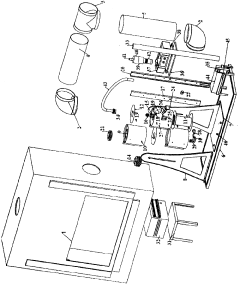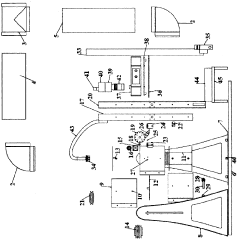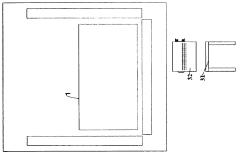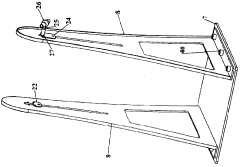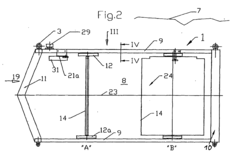How to Harness Laminar Flow for Power Generation?
JUL 10, 20259 MIN READ
Generate Your Research Report Instantly with AI Agent
Patsnap Eureka helps you evaluate technical feasibility & market potential.
Laminar Flow Power Gen Background and Objectives
Laminar flow power generation represents an innovative approach to harnessing energy from fluid dynamics. This technology leverages the predictable and stable characteristics of laminar flow, where fluid particles move in parallel layers without mixing. The concept has its roots in the fundamental principles of fluid mechanics, first described by Osborne Reynolds in the late 19th century.
The evolution of laminar flow power generation has been driven by the increasing demand for sustainable and efficient energy sources. As traditional power generation methods face environmental and efficiency challenges, researchers and engineers have turned to alternative technologies that can exploit natural phenomena with minimal environmental impact.
The primary objective of laminar flow power generation is to convert the kinetic energy of smoothly flowing fluids into electrical power. This approach aims to overcome the limitations of turbulent flow-based systems, which often suffer from energy losses due to friction and turbulence. By maintaining laminar flow conditions, the technology seeks to maximize energy extraction efficiency while minimizing wear and tear on system components.
One of the key goals in this field is to develop scalable systems that can be deployed in various environments, from small-scale applications in microfluidic devices to larger installations in natural water bodies or industrial settings. Researchers are exploring ways to optimize the geometry of flow channels, enhance the properties of working fluids, and improve energy conversion mechanisms to increase the overall system efficiency.
Another critical objective is to integrate laminar flow power generation with existing infrastructure and renewable energy systems. This integration could potentially lead to hybrid energy solutions that combine the stability of laminar flow power with other intermittent renewable sources, such as solar or wind power.
The technology also aims to address the challenges of low-flow environments, where traditional hydroelectric or tidal power systems are ineffective. By harnessing energy from slow-moving fluids in laminar regimes, this approach could unlock new power generation opportunities in previously untapped resources.
As the field progresses, there is a growing focus on developing smart, adaptive systems that can maintain optimal laminar flow conditions across varying environmental parameters. This involves incorporating advanced sensors, control systems, and machine learning algorithms to continuously adjust and optimize power generation processes.
The evolution of laminar flow power generation has been driven by the increasing demand for sustainable and efficient energy sources. As traditional power generation methods face environmental and efficiency challenges, researchers and engineers have turned to alternative technologies that can exploit natural phenomena with minimal environmental impact.
The primary objective of laminar flow power generation is to convert the kinetic energy of smoothly flowing fluids into electrical power. This approach aims to overcome the limitations of turbulent flow-based systems, which often suffer from energy losses due to friction and turbulence. By maintaining laminar flow conditions, the technology seeks to maximize energy extraction efficiency while minimizing wear and tear on system components.
One of the key goals in this field is to develop scalable systems that can be deployed in various environments, from small-scale applications in microfluidic devices to larger installations in natural water bodies or industrial settings. Researchers are exploring ways to optimize the geometry of flow channels, enhance the properties of working fluids, and improve energy conversion mechanisms to increase the overall system efficiency.
Another critical objective is to integrate laminar flow power generation with existing infrastructure and renewable energy systems. This integration could potentially lead to hybrid energy solutions that combine the stability of laminar flow power with other intermittent renewable sources, such as solar or wind power.
The technology also aims to address the challenges of low-flow environments, where traditional hydroelectric or tidal power systems are ineffective. By harnessing energy from slow-moving fluids in laminar regimes, this approach could unlock new power generation opportunities in previously untapped resources.
As the field progresses, there is a growing focus on developing smart, adaptive systems that can maintain optimal laminar flow conditions across varying environmental parameters. This involves incorporating advanced sensors, control systems, and machine learning algorithms to continuously adjust and optimize power generation processes.
Market Analysis for Laminar Flow Energy Solutions
The market for laminar flow energy solutions is experiencing significant growth as the world shifts towards sustainable and efficient power generation methods. This emerging technology harnesses the potential of laminar flow, a smooth and predictable fluid motion, to generate electricity. The global demand for clean energy solutions has created a fertile ground for innovative power generation technologies, and laminar flow energy systems are positioned to capture a substantial share of this expanding market.
Current market analysis indicates that the laminar flow energy sector is still in its early stages but shows promising potential. The technology's ability to generate power from low-velocity fluid flows makes it particularly attractive for applications in rivers, tidal streams, and industrial processes. As traditional hydroelectric power faces challenges due to environmental concerns and limited suitable locations, laminar flow energy solutions offer a less intrusive alternative with a broader range of potential deployment sites.
The market for laminar flow energy solutions is primarily driven by increasing environmental regulations, growing energy demand, and the need for diversification in renewable energy sources. Governments worldwide are implementing policies to reduce carbon emissions and promote clean energy adoption, creating a favorable regulatory environment for laminar flow energy technologies. Additionally, the rising costs of fossil fuels and the volatility of energy markets are pushing both public and private sectors to invest in alternative energy solutions.
Industry experts project that the laminar flow energy market will experience robust growth over the next decade. While specific market size projections vary, there is a consensus that the compound annual growth rate (CAGR) for this sector will outpace many traditional energy markets. The increasing focus on decentralized power generation and microgrid systems further amplifies the potential for laminar flow energy solutions, especially in remote or off-grid locations.
Key market segments for laminar flow energy solutions include small-scale hydropower, tidal energy, and industrial energy recovery systems. The technology's scalability allows for applications ranging from powering individual households to supporting larger community-based energy projects. Developing countries with abundant water resources but limited access to electricity grids represent a particularly promising market, as laminar flow energy systems can provide a sustainable and locally manageable power source.
Despite the positive outlook, the market for laminar flow energy solutions faces several challenges. These include high initial investment costs, the need for further technological advancements to improve efficiency, and competition from other renewable energy sources such as solar and wind power. However, ongoing research and development efforts are addressing these challenges, focusing on improving the cost-effectiveness and performance of laminar flow energy systems.
Current market analysis indicates that the laminar flow energy sector is still in its early stages but shows promising potential. The technology's ability to generate power from low-velocity fluid flows makes it particularly attractive for applications in rivers, tidal streams, and industrial processes. As traditional hydroelectric power faces challenges due to environmental concerns and limited suitable locations, laminar flow energy solutions offer a less intrusive alternative with a broader range of potential deployment sites.
The market for laminar flow energy solutions is primarily driven by increasing environmental regulations, growing energy demand, and the need for diversification in renewable energy sources. Governments worldwide are implementing policies to reduce carbon emissions and promote clean energy adoption, creating a favorable regulatory environment for laminar flow energy technologies. Additionally, the rising costs of fossil fuels and the volatility of energy markets are pushing both public and private sectors to invest in alternative energy solutions.
Industry experts project that the laminar flow energy market will experience robust growth over the next decade. While specific market size projections vary, there is a consensus that the compound annual growth rate (CAGR) for this sector will outpace many traditional energy markets. The increasing focus on decentralized power generation and microgrid systems further amplifies the potential for laminar flow energy solutions, especially in remote or off-grid locations.
Key market segments for laminar flow energy solutions include small-scale hydropower, tidal energy, and industrial energy recovery systems. The technology's scalability allows for applications ranging from powering individual households to supporting larger community-based energy projects. Developing countries with abundant water resources but limited access to electricity grids represent a particularly promising market, as laminar flow energy systems can provide a sustainable and locally manageable power source.
Despite the positive outlook, the market for laminar flow energy solutions faces several challenges. These include high initial investment costs, the need for further technological advancements to improve efficiency, and competition from other renewable energy sources such as solar and wind power. However, ongoing research and development efforts are addressing these challenges, focusing on improving the cost-effectiveness and performance of laminar flow energy systems.
Current Challenges in Laminar Flow Energy Harvesting
Laminar flow energy harvesting faces several significant challenges that hinder its widespread adoption and commercial viability. One of the primary obstacles is the inherently low energy density of laminar flows. Unlike turbulent flows, which contain more kinetic energy, laminar flows typically have lower velocities and less energy available for extraction. This limitation necessitates larger-scale installations or multiple units to generate meaningful power output, potentially increasing costs and complexity.
Another critical challenge lies in the design and optimization of energy harvesting devices for laminar flow conditions. Traditional turbine-based systems often perform poorly in laminar regimes, requiring novel approaches and specialized designs. Engineers must develop innovative mechanisms that can efficiently capture energy from slow, steady flows without disrupting the laminar characteristics. This demands a delicate balance between maximizing energy extraction and maintaining flow stability.
The intermittent nature of many laminar flow sources poses additional difficulties. Natural laminar flows, such as those found in rivers or ocean currents, may vary in strength and direction over time. This variability complicates the design of reliable and consistent power generation systems, necessitating advanced control strategies and energy storage solutions to manage fluctuations in output.
Scaling up laminar flow energy harvesting technologies presents another set of challenges. While small-scale demonstrations have shown promise, translating these concepts to larger, commercially viable installations remains problematic. Issues such as flow uniformity, structural integrity, and system efficiency become more pronounced at larger scales, requiring careful engineering and extensive testing.
Environmental concerns and regulatory hurdles also impact the development of laminar flow energy harvesting. Installations in natural water bodies may face scrutiny regarding their ecological impact, particularly on aquatic life and sediment transport. Obtaining necessary permits and adhering to environmental regulations can be time-consuming and costly, potentially deterring investment and slowing technological progress.
Material limitations further complicate the advancement of laminar flow energy harvesting. Devices must withstand prolonged exposure to water and potential corrosion while maintaining optimal performance. Developing durable, cost-effective materials that can operate efficiently in these conditions remains an ongoing challenge for researchers and engineers in the field.
Lastly, the economic viability of laminar flow energy harvesting technologies remains uncertain. The relatively low power output compared to other renewable energy sources, combined with high initial investment costs, makes it difficult to compete with established alternatives. Improving overall system efficiency, reducing manufacturing and maintenance costs, and identifying high-value niche applications are crucial steps towards making laminar flow energy harvesting economically feasible.
Another critical challenge lies in the design and optimization of energy harvesting devices for laminar flow conditions. Traditional turbine-based systems often perform poorly in laminar regimes, requiring novel approaches and specialized designs. Engineers must develop innovative mechanisms that can efficiently capture energy from slow, steady flows without disrupting the laminar characteristics. This demands a delicate balance between maximizing energy extraction and maintaining flow stability.
The intermittent nature of many laminar flow sources poses additional difficulties. Natural laminar flows, such as those found in rivers or ocean currents, may vary in strength and direction over time. This variability complicates the design of reliable and consistent power generation systems, necessitating advanced control strategies and energy storage solutions to manage fluctuations in output.
Scaling up laminar flow energy harvesting technologies presents another set of challenges. While small-scale demonstrations have shown promise, translating these concepts to larger, commercially viable installations remains problematic. Issues such as flow uniformity, structural integrity, and system efficiency become more pronounced at larger scales, requiring careful engineering and extensive testing.
Environmental concerns and regulatory hurdles also impact the development of laminar flow energy harvesting. Installations in natural water bodies may face scrutiny regarding their ecological impact, particularly on aquatic life and sediment transport. Obtaining necessary permits and adhering to environmental regulations can be time-consuming and costly, potentially deterring investment and slowing technological progress.
Material limitations further complicate the advancement of laminar flow energy harvesting. Devices must withstand prolonged exposure to water and potential corrosion while maintaining optimal performance. Developing durable, cost-effective materials that can operate efficiently in these conditions remains an ongoing challenge for researchers and engineers in the field.
Lastly, the economic viability of laminar flow energy harvesting technologies remains uncertain. The relatively low power output compared to other renewable energy sources, combined with high initial investment costs, makes it difficult to compete with established alternatives. Improving overall system efficiency, reducing manufacturing and maintenance costs, and identifying high-value niche applications are crucial steps towards making laminar flow energy harvesting economically feasible.
Existing Laminar Flow Power Generation Methods
01 Laminar flow turbines for power generation
Utilizing laminar flow principles in turbine design to generate power more efficiently. These turbines are designed to maintain smooth, predictable fluid flow patterns, reducing energy loss due to turbulence and increasing overall power output.- Laminar flow turbine design for power generation: Turbines designed to utilize laminar flow for power generation, optimizing efficiency and reducing turbulence. These designs may incorporate specific blade shapes, flow channels, or other features to maintain laminar flow conditions and maximize energy extraction from fluid streams.
- Laminar flow in microfluidic power generation systems: Microfluidic devices that leverage laminar flow characteristics for power generation on a small scale. These systems may use electrokinetic effects, piezoelectric materials, or other mechanisms to convert the energy of laminar fluid flow into electrical power.
- Laminar flow control in wind turbines: Methods and systems for maintaining or inducing laminar flow conditions on wind turbine blades to improve efficiency and power output. This may include surface treatments, active flow control mechanisms, or blade design optimizations.
- Laminar flow in hydroelectric power systems: Hydroelectric power generation systems that utilize laminar flow principles to improve efficiency and reduce environmental impact. This may include novel designs for water intakes, channels, or turbine configurations that maintain laminar flow conditions.
- Measurement and control systems for laminar flow power generation: Specialized sensors, measurement techniques, and control systems designed to monitor and maintain laminar flow conditions in power generation applications. These may include flow visualization methods, adaptive control algorithms, or real-time flow adjustment mechanisms.
02 Laminar flow in wind energy systems
Applying laminar flow concepts to wind energy systems, including wind turbine blade design and wind farm layout optimization. This approach aims to maximize energy capture from wind resources while minimizing interference between turbines.Expand Specific Solutions03 Laminar flow in hydroelectric power generation
Implementing laminar flow principles in hydroelectric power systems to improve efficiency. This includes optimizing water flow in dams, turbines, and pipelines to reduce energy loss and increase power output from water resources.Expand Specific Solutions04 Laminar flow in microfluidic power generation
Developing microfluidic devices that leverage laminar flow for small-scale power generation. These systems could be used in portable electronics, medical devices, or other applications requiring miniaturized power sources.Expand Specific Solutions05 Measurement and control systems for laminar flow power generation
Creating advanced measurement and control systems to monitor and optimize laminar flow in power generation applications. These systems use sensors and algorithms to maintain ideal flow conditions and maximize energy efficiency.Expand Specific Solutions
Key Players in Laminar Flow Energy Industry
The competition landscape for harnessing laminar flow for power generation is in its early stages, with the market still developing and relatively small. The technology is not yet fully mature, with ongoing research and development efforts at various institutions. Companies like Sony Group Corp. and Alstom SA are exploring potential applications, while academic institutions such as Tianjin University, Zhejiang University, and Kyoto University are conducting fundamental research. The involvement of energy companies like Osaka Gas Co., Ltd. and Saudi Arabian Oil Co. suggests growing interest in the technology's potential for sustainable energy production. As the field progresses, we can expect increased collaboration between industry and academia to overcome technical challenges and scale up the technology for commercial use.
Alstom SA
Technical Solution: Alstom has developed a novel approach to harnessing laminar flow for power generation in hydroelectric applications. Their system utilizes specially designed intake structures that promote laminar flow conditions in large-scale water conduits. This laminar flow is then directed through a series of advanced, low-head turbines optimized for non-turbulent water movement[5]. Alstom's technology incorporates adaptive blade geometry that can adjust in real-time to maintain optimal energy extraction across varying flow rates. The company has also implemented advanced computational fluid dynamics modeling to predict and optimize system performance under different environmental conditions[7].
Strengths: Applicable to large-scale hydroelectric projects, high efficiency in low-head conditions, adaptable to varying water flow rates. Weaknesses: Requires significant initial infrastructure investment, may have environmental impacts on aquatic ecosystems, performance can be affected by seasonal water level changes.
Saudi Arabian Oil Co.
Technical Solution: Saudi Aramco has developed innovative laminar flow-based power generation systems for oil and gas operations. Their approach utilizes the natural pressure differentials in pipelines to create controlled laminar flow conditions. This is then harnessed through specially designed turbines that can efficiently extract energy from the low-velocity, non-turbulent fluid movement[1]. The company has implemented this technology in several of its facilities, integrating it with existing infrastructure to minimize additional capital costs. Aramco's system includes advanced flow sensors and adaptive control algorithms to optimize power generation across varying flow conditions, ensuring consistent output even as pipeline pressures fluctuate[3].
Strengths: Leverages existing infrastructure, low maintenance due to laminar flow, highly efficient in low-velocity conditions. Weaknesses: Limited to pipeline environments, output may vary with flow rates, initial implementation costs can be high.
Innovative Laminar Flow Energy Conversion Technologies
Device for generating laminar flow implemented in a tubular furnace.
PatentActiveMX2017015541A
Innovation
- A laminar flow emitter device is integrated into a tubular oven with a piezoelectric system operating at 0.8 MHz to generate aerosols, surrounded by four cylindrical ducts that maintain laminar flow and prevent turbulence, allowing for both horizontal and vertical orientations, with independently controlled gas flows to enhance aerosol delivery.
Power generation apparatus from the energy of flowing water
PatentInactiveEP1085642A3
Innovation
- A modular device using carriages with magnets and coil windings in a linear generator, where the wing extends transversely to convert water flow energy into electricity, tilting 90 degrees to reduce resistance and return, eliminating the need for turbines, and utilizing fiber-reinforced composite materials for lightweight construction and corrosion resistance.
Environmental Impact of Laminar Flow Energy Solutions
Laminar flow energy solutions present a promising avenue for sustainable power generation, but their environmental impact must be carefully considered. These systems typically harness the smooth, predictable flow of fluids to generate electricity, offering a potentially cleaner alternative to traditional power sources. However, the implementation of such technologies can have both positive and negative effects on the surrounding ecosystem.
One of the primary environmental benefits of laminar flow energy solutions is their potential to reduce greenhouse gas emissions. Unlike fossil fuel-based power plants, these systems do not rely on combustion processes, thereby significantly decreasing carbon dioxide and other harmful emissions. This aspect aligns with global efforts to combat climate change and transition towards cleaner energy sources.
The installation of laminar flow energy systems often requires minimal land use compared to large-scale solar or wind farms. This reduced footprint can help preserve natural habitats and minimize ecosystem disruption. Additionally, these systems can be integrated into existing infrastructure, such as water treatment plants or industrial facilities, further reducing their environmental impact.
However, the introduction of laminar flow energy solutions may alter local hydrodynamics, potentially affecting aquatic ecosystems. Changes in water flow patterns could impact the migration and breeding habits of fish and other aquatic species. Careful environmental assessments and mitigation strategies are necessary to minimize these potential disruptions.
The materials used in constructing laminar flow energy systems also warrant consideration. While many components can be made from recyclable materials, the production and eventual disposal of specialized equipment may have environmental implications. Lifecycle assessments should be conducted to ensure that the overall environmental benefits outweigh the costs associated with manufacturing and decommissioning.
Noise pollution is another factor to consider, although laminar flow systems generally operate more quietly than traditional turbines. This reduced noise impact can be particularly beneficial in urban or sensitive ecological areas where noise disturbance could affect wildlife or human populations.
Water quality is a critical concern, especially for systems implemented in natural water bodies. Proper design and maintenance are essential to prevent the release of lubricants or other potentially harmful substances into the environment. Regular monitoring and stringent operational protocols can help safeguard water quality and protect aquatic life.
In conclusion, while laminar flow energy solutions offer significant environmental advantages, their implementation must be approached with careful consideration of potential ecological impacts. Comprehensive environmental impact assessments, ongoing monitoring, and adaptive management strategies are crucial to ensuring that these innovative power generation systems contribute positively to sustainable energy production while minimizing adverse effects on the environment.
One of the primary environmental benefits of laminar flow energy solutions is their potential to reduce greenhouse gas emissions. Unlike fossil fuel-based power plants, these systems do not rely on combustion processes, thereby significantly decreasing carbon dioxide and other harmful emissions. This aspect aligns with global efforts to combat climate change and transition towards cleaner energy sources.
The installation of laminar flow energy systems often requires minimal land use compared to large-scale solar or wind farms. This reduced footprint can help preserve natural habitats and minimize ecosystem disruption. Additionally, these systems can be integrated into existing infrastructure, such as water treatment plants or industrial facilities, further reducing their environmental impact.
However, the introduction of laminar flow energy solutions may alter local hydrodynamics, potentially affecting aquatic ecosystems. Changes in water flow patterns could impact the migration and breeding habits of fish and other aquatic species. Careful environmental assessments and mitigation strategies are necessary to minimize these potential disruptions.
The materials used in constructing laminar flow energy systems also warrant consideration. While many components can be made from recyclable materials, the production and eventual disposal of specialized equipment may have environmental implications. Lifecycle assessments should be conducted to ensure that the overall environmental benefits outweigh the costs associated with manufacturing and decommissioning.
Noise pollution is another factor to consider, although laminar flow systems generally operate more quietly than traditional turbines. This reduced noise impact can be particularly beneficial in urban or sensitive ecological areas where noise disturbance could affect wildlife or human populations.
Water quality is a critical concern, especially for systems implemented in natural water bodies. Proper design and maintenance are essential to prevent the release of lubricants or other potentially harmful substances into the environment. Regular monitoring and stringent operational protocols can help safeguard water quality and protect aquatic life.
In conclusion, while laminar flow energy solutions offer significant environmental advantages, their implementation must be approached with careful consideration of potential ecological impacts. Comprehensive environmental impact assessments, ongoing monitoring, and adaptive management strategies are crucial to ensuring that these innovative power generation systems contribute positively to sustainable energy production while minimizing adverse effects on the environment.
Scalability and Integration of Laminar Flow Power Systems
The scalability and integration of laminar flow power systems present both challenges and opportunities for widespread adoption. As the technology matures, scaling up these systems to meet larger energy demands becomes crucial. One approach involves modular design, allowing for the interconnection of multiple smaller units to create larger power generation arrays. This modular approach offers flexibility in deployment and maintenance, as individual units can be added or replaced as needed.
Integration with existing infrastructure is another key consideration. Laminar flow power systems can be incorporated into buildings, water treatment facilities, and industrial processes where controlled fluid flow already exists. This integration can significantly reduce implementation costs and increase overall system efficiency. For instance, in urban environments, these systems could be integrated into water distribution networks, harnessing energy from the flow within pipes that would otherwise be lost.
The scalability of laminar flow power systems also extends to their application in various environments. From small-scale implementations in residential settings to large-scale installations in industrial complexes, the technology can be adapted to suit different power generation needs. This versatility is particularly valuable in remote or off-grid locations where traditional power sources may be impractical or unavailable.
However, scaling up laminar flow power systems also presents technical challenges. As the size of the system increases, maintaining laminar flow becomes more difficult due to the increased likelihood of turbulence. Engineers must develop innovative designs and materials to preserve laminar flow conditions in larger-scale applications. Additionally, the integration of these systems with existing power grids requires careful consideration of power quality, frequency regulation, and load balancing.
The economic viability of scaled-up laminar flow power systems is another critical factor. As the technology advances and production scales up, the cost per unit of power generated is expected to decrease, making it more competitive with conventional energy sources. However, this requires continued investment in research and development to optimize system design and manufacturing processes.
In conclusion, the scalability and integration of laminar flow power systems hold significant promise for sustainable energy generation. By addressing technical challenges, optimizing designs for various scales, and seamlessly integrating with existing infrastructure, these systems have the potential to become a valuable component of the global renewable energy mix.
Integration with existing infrastructure is another key consideration. Laminar flow power systems can be incorporated into buildings, water treatment facilities, and industrial processes where controlled fluid flow already exists. This integration can significantly reduce implementation costs and increase overall system efficiency. For instance, in urban environments, these systems could be integrated into water distribution networks, harnessing energy from the flow within pipes that would otherwise be lost.
The scalability of laminar flow power systems also extends to their application in various environments. From small-scale implementations in residential settings to large-scale installations in industrial complexes, the technology can be adapted to suit different power generation needs. This versatility is particularly valuable in remote or off-grid locations where traditional power sources may be impractical or unavailable.
However, scaling up laminar flow power systems also presents technical challenges. As the size of the system increases, maintaining laminar flow becomes more difficult due to the increased likelihood of turbulence. Engineers must develop innovative designs and materials to preserve laminar flow conditions in larger-scale applications. Additionally, the integration of these systems with existing power grids requires careful consideration of power quality, frequency regulation, and load balancing.
The economic viability of scaled-up laminar flow power systems is another critical factor. As the technology advances and production scales up, the cost per unit of power generated is expected to decrease, making it more competitive with conventional energy sources. However, this requires continued investment in research and development to optimize system design and manufacturing processes.
In conclusion, the scalability and integration of laminar flow power systems hold significant promise for sustainable energy generation. By addressing technical challenges, optimizing designs for various scales, and seamlessly integrating with existing infrastructure, these systems have the potential to become a valuable component of the global renewable energy mix.
Unlock deeper insights with Patsnap Eureka Quick Research — get a full tech report to explore trends and direct your research. Try now!
Generate Your Research Report Instantly with AI Agent
Supercharge your innovation with Patsnap Eureka AI Agent Platform!
